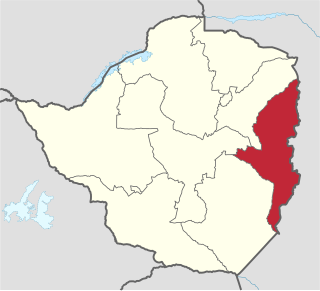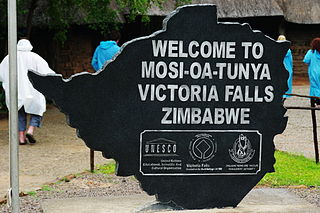Shona is a Bantu language of the Shona people of Zimbabwe. The term is variously used to collectively describe all the Central Shonic varieties or specifically Standard Shona, a variety codified in the mid-20th century. Using the broader term, the language is spoken by over 14,000,000 people.

The Kingdom of Mutapa – sometimes referred to as the Mutapa Empire, Mwenemutapa, – was an African kingdom in Zimbabwe, which expanded to what is now modern-day Mozambique.

Manicaland is a province in eastern Zimbabwe. After Harare Province, it is the country's second-most populous province, with a population of 2.037 million, as of the 2022 census. After Harare and Bulawayo provinces, Manicaland is Zimbabwe's third-most densely populated province. Manicaland was one of five original provinces established in Southern Rhodesia in the early colonial period. The province endowed with country's major tourist attractions, the likes of Mutarazi Falls, Nyanga National Park and Zimbabwe's top three highest peaks. The province is divided into ten administrative subdivisions of seven rural districts and three towns/councils, including the provincial capital, Mutare. The name Manicaland is derived from one of the province's largest ethnic groups, the Manyika, who originate from the area north of the Manicaland province and as well as western Mozambique, who speak a distinct language called ChiManyika in Shona.

Masvingo, previously named Victoria, is a province in southeastern Zimbabwe. It has a population of 1.638 million as of the 2022 census, ranking fifth out of Zimbabwe's ten provinces. Established by the British South Africa Company, it was one of the five original provinces of Southern Rhodesia. In 1982, two years after Zimbabwean independence, it was renamed Masvingo Province. The province is divided into seven districts, including Masvingo District, which contains the provincial capital Masvingo City.

Mutare, formerly known as Umtali until 1982, is the most populous city in the province of Manicaland, and the third most populous in Zimbabwe, having surpassed Gweru in the 2012 census, with an urban population of 224,802 and approximately 260,567 in the surrounding districts, giving the wider metropolitan area a total population of over 500,000 people. Mutare is also the capital of Manicaland Province and the largest city in eastern Zimbabwe.
Manyika is a Shona language largely spoken by the Manyika tribe in the eastern part of Zimbabwe and across the border in Mozambique. It includes dialects ChiBocha, ChiUngwe, and ChiManyika, from which the broad Manyika language gets its name.

The Shona people are a Bantu ethnic group native to Southern Africa, primarily living in Zimbabwe where they form the majority of the population, as well as Mozambique, South Africa, and a worldwide diaspora. There are five major Shona language/dialect clusters: Manyika, Karanga, Zezuru, Korekore, and Ndau.

Buhera District is a district in Manicaland Province, in eastern Zimbabwe.

Cashel is a village in Chimanimani District of Manicaland Province, Zimbabwe. It is located near the Mozambique border, just north of the Chimanimani Mountains. Forestry, bananas, wheat, and various cash crops are grown in the area. It was originally called Penkridge but was changed to Cashel in 1957. It was named after Lt. Col. E. Cashel, a former member of the British South Africa Police and the Rhodesian Volunteers, who retired to this area after World War I. The Cashel valley is well known for radio and television commercials, which sought to extol the quality of its peas, beans and other agricultural products.

Nehanda Charwe Nyakasikana also known as Mbuya Nehanda was a svikiro, or spirit medium of the Zezuru Shona people. She was a medium of Nehanda, a female Shona mhondoro. As one of the spiritual leaders of the Shona, she was one of the leaders of a revolt, the Chimurenga, against the British South Africa Company's colonisation of what is now Zimbabwe led by Cecil John Rhodes in 1889. She was a Hera of the HwataShava Mufakose Dynasty. She and her ally Sekuru Kaguvi were eventually captured and executed by the company on charges of murder. She has been commemorated by Zimbabweans by statues, songs, novels, and poems, and the names of streets and hospitals. The legacy of the medium continued to be linked to the theme of resistance, particularly the guerrilla war that began in 1972. Her name became of increasing importance to the nationalist movements in Zimbabwe.
Watsomba is a shopping centre in the province of Manicaland, Zimbabwe located 42 km north of the city of Mutare on the main Mutare-Nyanga road. It is an administrative and trading centre for Mutasa District and the Mutasa and Manyika communal lands. Around Watsomba are farms surrounding the growth point namely ruwodo farm, muringami farm, sakupwanya farm, madziwa farm, sagonda farm, Nyamutaira farm, Mutasa farm, Mandimutsira farms, Mundoma farm, Mvere Farm, Nyakurukwa Farm and Makoni Farm.

Zimunya, also referred to by the Jindwi people of Zimunya as "Jindwi", is a Paramount Chiefdom in Manicaland Province, Zimbabwe under Chief Zimunya.

Makoni District is a district in Manicaland Province of northeastern Zimbabwe.

Mberengwa, originally known as Belingwe, is a district in Midlands province in Zimbabwe. The district is now divided into sub-districts: Mberengwa North, East, West and South. It is bounded by Gwanda in Mberengwa west, and by Zvishavane in its northern zone, to the south it stretches to Neshuro, Chikombedzi and bounded by Manyuchi dam.
The pre-colonial history of Zimbabwe lasted until the British government granted colonial status to Southern Rhodesia in 1923.
Mutasa District is one of seven districts in Manicaland Province of Zimbabwe. Mutasa District is located 30 km northeast of Mutare and stretches up to the Honde Valley, which is about 100 km northeast of Mutare along a tarred road that branches off the Nyanga road.

Many languages are spoken, or historically have been spoken, in Zimbabwe. Since the adoption of its 2013 Constitution, Zimbabwe has 16 official languages, namely Chewa, Chibarwe, English, Kalanga, Koisan, Nambya, Ndau, Ndebele, Shangani, Shona, sign language, Sotho, Tonga, Tswana, Venda, Xhosa. The country's main languages are Shona, spoken by only 42% of the population, and Ndebele, spoken by roughly 39%. English is the country's lingua franca, used in government and business and as the main medium of instruction in schools. English is the first language of most white Zimbabweans, and is the second language of a majority of black Zimbabweans. Historically, a minority of white Zimbabweans spoke Afrikaans, Greek, Italian, Polish, and Portuguese, among other languages, while Gujarati and Hindi could be found amongst the country's Indian population. Deaf Zimbabweans commonly use one of several varieties of Zimbabwean Sign Language, with some using American Sign Language. Zimbabwean language data is based on estimates, as Zimbabwe has never conducted a census that enumerated people by language.

The Kingdom of Zimbabwe was a medieval Shona kingdom located in modern-day Zimbabwe. Its capital, today's Masvingo, which is commonly called Great Zimbabwe, is the largest stone structure in precolonial Southern Africa. This kingdom came about after the collapse of the Kingdom of Mapungubwe.

Christianity is the largest religion practiced in Zimbabwe, accounted for more than 84% of the population. The arrival of Christianity dates back to the 16th century by Portuguese missionaries such as Fr. Gonsalo Da Silveira of the Roman Catholic Church. Christianity is embraced by the majority of the population. It is estimated 85 percent of Zimbabweans claim to be Christians, with approximately 62 percent regularly attending church services. Christian faith plays a very important role in the organization of Zimbabwean society.
Joyce Simango is a Zimbabwean author. She became the first female Shona novelist when she published Zviuya Zviri Mberi, or "Good Things are Ahead", in 1974.











